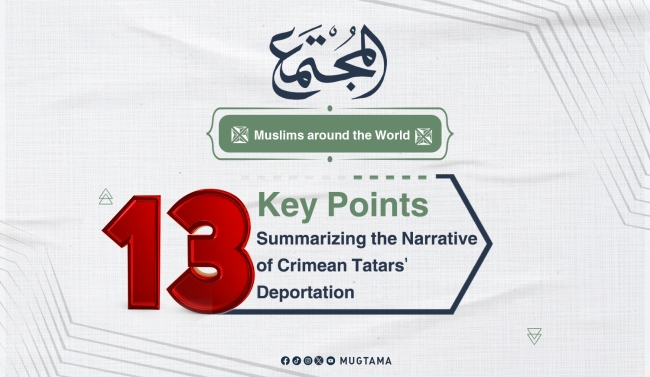April 03, 2025
13 Key Points Summarizing the Narrative of Crimean Tatars' Deportation
Every year on May 18, the Crimean Tatars commemorate the anniversary of their forced deportation from their homeland in the Crimean Peninsula at the hands of the Soviet dictator Joseph Stalin in 1944. During this time, Stalin decided to forcibly deport them, relocating tens of thousands to Siberia, central Russia, and the Central Asian republics, which were part of the Soviet Union at that time. What is the story of their deportation?
- The Crimean Peninsula is located south of Ukraine, north of the Black Sea, with the Kerch Strait separating it from Russia to the east.
- The Crimean Tatars are a Turkish people and the indigenous population of the disputed Crimean Peninsula between Russia and Ukraine.
- The origins of the Crimean Tatars trace back to Turkish tribes that settled in the Crimea during the Abbasid era, and they established a strong state from the eighth century AH until it was annexed by the Ottoman Empire before falling into Russian hands in 1783.
- Among the reasons for the deportation in 1944 were accusations from the Soviet Union, led by Joseph Stalin, alleging that the Crimean Tatars collaborated with German forces during World War II.
- On May 18, 1944, Stalin issued a decree for their forcible deportation from their historical homeland.
- According to historical sources, 180,000 of them were deported within just three days to areas in Siberia, central Russia, and the Central Asian republics that were under Soviet rule at the time.
- Families were given only 15 minutes to prepare for departure, with restrictions prohibiting them from taking any of their belongings.
- They were placed in closed freight trains that were used for transporting animals, leading to the deaths of thousands during the forced deportation process.
- Approximately 40% of them died during the deportation and in the early years that followed due to diseases, hunger, and harsh living conditions.
- In February 1954, the Soviet Union transferred the jurisdiction of the Crimean Peninsula from Russia to Ukraine, and after the dissolution of the Soviet Union in 1991, it remained part of Ukraine.
- Their homes and lands were confiscated and distributed to Russian workers who were brought in and settled in the place of the Crimean Tatars in the Crimea.
- At the beginning of 1987, some Crimean Tatars began to return to their lands without any rights or compensation for the forced deportation or for the confiscation of their properties.
- Russia annexed the Crimean Peninsula in March 2014 through a unilateral referendum.


